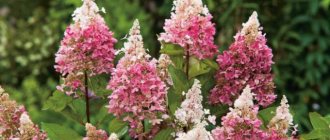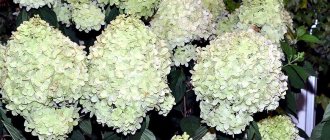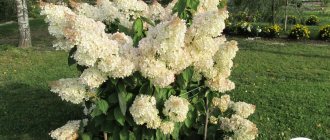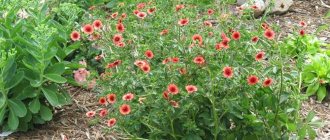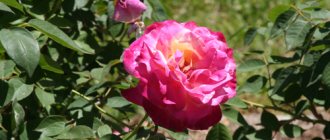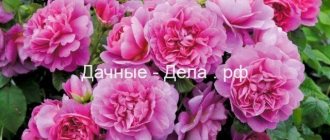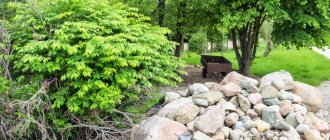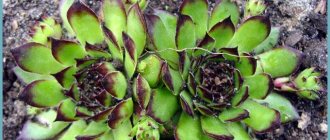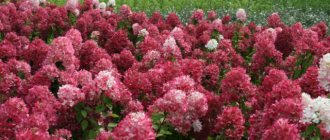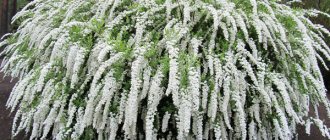History of selection
The Hydrangea paniculata variety Sunday Fries was bred through selection in the French nurseries Renault and Sapho by Jean Reno and introduced into commercial circulation in 2010.
The Sunday Fraise variety was obtained from the previously bred Vanille Fraise variety and is distinguished by its height and compactness.
In 2010, the Sundae Fraise variety was awarded a silver medal at the International Plantarium Exhibition (Boskop Netherlands). The variety is patented; reproduction without paying for a license is punishable by law.
Further care of flowering shrubs
Sundae Fraise hydrangea is easy to grow and care for. Once the shrub gets stronger, it does not require as much watering as other Hydrangea varieties.
Watering
The main problem of this plant during the first year after planting is lack of water. In spring and summer it is necessary to water abundantly so that the water can penetrate to the deepest roots of the Hydrangea. During hot and dry periods, give 2 buckets every three to four days.
Be careful to direct the water stream into the soil when soaking flowers and leaves.
Fertilizer
Feed the bush once in the spring with a fertilizer designed for flowering shrubs (with plenty of phosphorus). Soils should be moist but well drained and rich in organic matter.
You might be interested
The best perennial bush flowers for the garden: features and selection rules
The best 30 varieties of Hydrangea paniculata with names and photos
Hydrangea paniculata variety "Weems Red"
Weed control
Competition from grass and weeds, which are much more efficient at absorbing water and nutrients, can stifle the growth of ornamental shrubs. For 3 years after planting, it is important that your single bush or hedge has a one meter wide area completely free of grass.
Place a thick layer of bark mulch firmly around the Hydrangea stems. This will not only stop weeds from growing, but will also retain moisture during the hot summer months.
Mowing the lawn is not the answer to a weed problem. Every time you mow, the grass will grow more vigorously.
Pruning Hydrangea 'Sunday Fries'
If left unpruned, the shrub will develop into a multi-stemmed tree-like form. If you want a bumper crop of delicious flower heads, it's a good idea to prune back about two-thirds of last year's growth each spring. This promotes the formation of a dense crown and strong, compact flowers.
Description of hydrangea Sunday Fries
Hydrangea Sundae Fraise belongs to the category of new varieties. But at the same time, it has already gained wide popularity not only among landscape designers, but also among amateur flower growers. This was due to the high decorative qualities of the plant and its relative ease of care.
Hydrangea Sunday Fries is characterized by compact bushes
Hydrangea paniculata Sunday Fries has French roots. She was bred thanks to the efforts of Jeannot Reno. His goal was to obtain a compact perennial shrub with delicate, elegant inflorescences. And he managed to do this about 10 years ago.
Detailed description
Sunday Fraise (paniculata sundae fraise) is a hydrangea variety that blooms from mid-June to September (in the south - until October). It produces lush, very beautiful flowers (diameter up to 2.5 cm) of white, light and deep pink shades with openwork petals. Moreover, light flowers appear first, then they become soft pink, after which they acquire the brightest color.
This variety was bred in 2010, but within a few years Sunday Fries managed to spread widely, including in Russia. The bush has a thick, beautiful crown of dark green shades. The leaves are large, growing up to 10-12 cm in length. At the same time, they are narrow, look miniature and serve as an excellent background for lush inflorescences.
Hydrangea Sunday Fries reaches no more than a meter in height. But the bush grows well to the sides, while remaining compact and attractive. A distinctive feature is that the plant independently takes on the shape of a ball, so it does not require special shaping. It is enough to carry out only anti-aging pruning 1-2 times per season.
Sunday Frize is distinguished by beautiful flowers of pale pink color, collected in lush panicles.
Important! Hydrangea Sunday Fries can be grown both in the Moscow region and the central part, as well as in other regions (Ural, Siberia). But in the latter case, you will need to carefully cover the bush for the winter, otherwise it may not survive extreme frosts.
Appearance
This culture was developed by the famous French breeder J. Reno. The variety appeared in 2010 and in a short period of time gained popularity among many gardeners. The plant has become a more advanced version of the Vanilla Frize culture.
Hydrangea is characterized by lush flowering
For your information! When breeding this variety, the scientist took into account all the disadvantages of the parent culture. The result was an ideal plant. In 2010, hydrangea Sundae (Sandai) was awarded a silver medal in Holland.
Paniculata hydrangea Sunday Fries is characterized by spreading bushes. If you want to get a denser structure, it is recommended to tie the plant.
The shoots of the plant have a burgundy color and oval leaf blades. There is an edge on each side of the leaves. The foliage below is more covered with fluff. This is especially pronounced in areas where veins are located.
This variety is characterized by large pyramidal inflorescences that resemble panicles in shape. They grow up to 30 cm in length and have approximately the same diameter. In appearance, the flowers resemble ice cream, which is why they are often called strawberry ice cream.
Note! The inflorescences contain sterile and fruiting flowers. The former have larger sizes and longer flowering.
Gorgeous hydrangea inflorescences adorn the bushes all summer. The description of the culture says that they begin to bloom from mid-June to the end of autumn. During the flowering period the bushes look simply amazing. At the initial stage, the bushes are decorated with white buds. Then they gradually acquire a pink color. Towards the end of flowering the shade becomes very bright.
On 1 bush there are several shades of flowers at once. Thanks to this, it looks very attractive. Climatic features and soil acidity parameters are of no small importance. The intensity of the color depends on these factors: the more acidic the soil, the brighter the flowers.
When grown in acidic soil, the bushes are decorated with bright inflorescences
Features of flowering
Sunday Fries blooms, starting in June, with white and soft pink flowers, collected in pyramidal panicles up to 30 cm long. At first they are painted only white, but a little later a pink tint appears, and closer to the end of flowering - bright crimson. The saturation of the color depends primarily on the acidity of the soil in which the shrub grows.
Did you know? Breeders call Sunday Fries nothing more than “strawberry ice cream.” This name was given to the variety for its delicate color.
Flowering time
At the same time, flowers of completely different colors can be located on the same bush.
- white color is the very beginning;
- pink – middle;
- bright crimson - flowering is coming to an end.
The intensity of the shade and color scheme of the inflorescences is influenced by the acidity of the earth: the higher it is, the more saturated the color of the flowers.
Hydrangea paniculata Sunday Fries has one more advantage over other varieties - it is incredible abundance and duration of flowering (mid-June - late October). Thanks to its unusual elongated shape and the length of the inflorescences (about 0.3 m), hydrangea attracts the admiring glances of any person.
Distinctive features
According to the description, Hydrangea Sundae Fraise is a deciduous perennial shrub with erect shoots. The height varies between 1.0-1.2 m, and the width of the rounded crown is 1.2 m. The plant is characterized by strong branches that can easily withstand the load during the flowering period.
Important! In many Western catalogs this variety is called Hydrangea paniculata "Rensun", which sometimes causes confusion.
The leaves of the plant are ellipsoidal in shape and reach a length of 12 cm. The plates are slightly pubescent on top and more pubescent on the reverse side. Their shade is light green. The shoots of this variety are brownish-brown in color with long internodes. The root system of Sunday Fraze hydrangea grows in width and is therefore located superficially.
Description of appearance and features
Sunday Frize is a miniature variety. Its maximum height is 120 cm, width - 1 meter. This is a slightly spreading shrub, so the plant does not hold its shape very well. At the same time, the crown is dense. On the red-brown stems there are elongated ovate or oblong dark green leaves, up to 12 cm in length, covered with pile on the outer and inner sides, most of all in the vein area. The shoots of the crop are not very strong and often droop during flowering.
In the first half of summer, large pyramidal inflorescences form on hydrangeas. They consist of small flowers: sterile, reaching 2.5 cm in diameter, and smaller fertile ones, with petals falling off early. The initial color of the inflorescences is white, but it is gradually replaced by a pink tint, and by autumn the flower “candles” turn crimson. The combination of shape and rich colors makes the inflorescences of this variety look like berry ice cream in a glass. For this reason, among gardeners, the shrub is often called “strawberry ice cream.” The ornamental plant blooms until October, and does so already in the first year after planting in the ground. The bush needs support, and its shoots need tying.
Sunday Frize is frost-resistant. She absolutely does not care about air temperatures dropping to -25ºС. The flower feels good in conditions of increased pollution and gas pollution in the surrounding atmosphere.
Characteristics of the variety
The Sunday Frize variety is valued due to its characteristics, among which the following are important:
- height - up to 1 meter;
- crown diameter - about 1 meter;
- inflorescences - panicles;
- flowering - from June to October;
- growth rate is quite fast;
- frost resistance - up to -20°C;
- soil is acidic;
- lighting - partial shade.
Flaws
- The need for abundant and frequent watering.
- Requirement for acidic soils.
- Low frost resistance.
- The need for shelter for the winter.
Winter hardiness
The Sunday Frize variety is characterized by moderate winter hardiness. The description states that Sunday Fries can withstand temperatures down to -20 degrees. If the indicator drops even lower (which happens every winter in the Urals and Siberia and often in the middle zone), the young shoots will die. Under these conditions, the apical flower buds will also freeze.
Therefore, Sunday Frize, like all other varieties of hydrangea with pink flowers, require mandatory shelter for the winter. It is made in a variety of ways - with burlap, plastic wrap, using foliage.
Another drawback of Sunday Fries hydrangea is that the plant loves water and lighting. Therefore, simply relying on rain watering will not work. The bush is also picky about the soil. It prefers fertile soil and regular fertilization.
If you provide your hydrangea with normal care, all your efforts are guaranteed to be rewarded.
Advantages
- Beautiful and long-lasting flowering with changing shades.
- Good tolerance to shade and partial shade.
- Excellent survivability in air pollution conditions.
- Hydrangea can be successfully planted along fences near highways.
Trimming
Sunday Fries is recommended to be regularly pruned each spring before the buds begin to swell. Cutting off at least two-thirds of the previous year's growth will produce a strong shrub with large inflorescences and a regular bush shape.
Hydrangea paniculata blooms on annual shoots, so it is not damaged by flower buds during spring frosts. Thanks to this, the Sunday Fries variety blooms reliably every year.
Reproduction methods
To obtain young seedlings of this paniculate hydrangea, it is recommended to use cuttings or layering.
Cuttings need to be cut 10-15 cm long
The first propagation method should be used in early June, when buds form on the bush. Cut cuttings with 2-3 leaves. In this case, remove the lower ones and cut the upper ones in half. Plant in a mixture of peat and sand. Seedlings take root in 3-4 weeks.
The second method is recommended to be used in early spring before the buds open. To do this, you need to loosen the soil at the base of the bush and make furrows 5-7 cm deep. Place the side shoots in them, sprinkle with earth, leaving only the top at the top.
Important! Rooted cuttings can only be separated from the mother bush next spring.
Cuttings
Cuttings are cut during anti-aging pruning of bushes. It is advisable to take them from side shoots so that they take root better. You need to cut off parts of the shoot with two pairs of leaves. The bottom two sheets must be removed immediately, and the top ones must be shortened by half. The cuttings are soaked for a couple of hours in a solution of a special product that helps them take root as quickly as possible. It may be "Kornevin", but if it is not there, you can dilute a teaspoon of honey in a glass of water. The effect will be almost the same.
After soaking, the cuttings are planted in soil consisting of peat and sand in equal parts. You can purchase a special substrate at the store for planting flowers. It is permissible to plant both in individual pots and in common containers.
As a rule, most cuttings are accepted well, take root, and subsequently grow into full-fledged bushes. The main thing is that they are deepened into the substrate by two buds, and you also need to remember to water them every day, and also protect them from direct sunlight and wind. For better protection, the containers are covered with film, which is removed only after the first sheets appear. Young plants can be left to winter outside, but to do this they must be covered with spruce branches.
Seedlings obtained from cuttings can be planted in a permanent place in the 2nd or 3rd year. This is the simplest method of reproduction, so it is used more often than others.
Did you know? Archaeologists have proven that hydrangea existed 40 thousand years ago.
By layering
This method differs in that it brings a small number of seedlings, but it is also used quite often. To obtain layering, branches are bent to the ground, secured and sprinkled with soil. For this purpose, you need to choose only the youngest and strongest.
The cuttings remain overwintering in this form, covered with spruce branches. And only next year they are separated from the mother plant and planted in a separate place in the garden, slightly shaded, without access to direct sunlight, where they will have to remain until they become full-fledged seedlings for planting in a permanent place.
Dividing the bush
This method is used quite rarely, because it can lead to damage to the root system or the entire plant. Therefore, only very old bushes that need to be transplanted to a new location are propagated by division.
Each divided bush is planted according to the same rules as purchased seedlings.
Propagation of Hydrangea 'Sunday Fries'
Reproduction can be done by lateral branches. Choose soft, flexible stems that will reach to the ground and allow the ends of the shoots to be about 30cm above the ground. Carefully cut the bark along the area that will touch the ground before securing it into the soil with wire hooks or similar on each side of the cut. To speed up rooting, you can use Kornevin. Carefully tie the end of the shoot so that it grows vertically.
Propagation by cuttings
Take semi-hard cuttings from the current year's growth, where the lower part of the branch is hard and the upper part is soft. Using a sharp knife, cut about 15 cm of the branches, remove the lowest leaves, dip the end in rooting hormone and place in a pot filled with soil mixture, water well. The soil should remain moist until rooting. Cover the container with film and keep it in partial shade.
Application in landscape design
Some gardeners call Sunday Fries "strawberry ice cream" because its flowers really resemble this delicious dessert. The bushes have a high decorative value and look good both in single plantings and in combination with other garden flowers. Here are some interesting examples:
- A flowering bush looks good against a background of smaller green plants, along paths or in the thick of the garden.
- Thanks to its spherical shape, Sunday Frize can be used for a rounded flower bed, the contour of which can be decorated with small stones.
- Another way to decorate is to plant a hydrangea bush in a small bucket that can be placed anywhere.
- Hydrangea Sunday Fries looks great next to paths and the house. It is she who creates the impression of a lush, blooming garden.
Sunday Frize, along with other varieties of hydrangea, look harmonious with each other. When creating a joint composition, you only need to trim all the plants in time so that they are approximately the same height.
Landing
Hydrangea Sunday Fries prefers humus substrates that are permeable with an acidic or neutral reaction. Requires sunny or semi-shaded and moderately humid places.
A little known fact, bushes planted in the fall and winter will be easier to care for than bushes planted in the spring and summer, the seedlings will have time to take root and become hardy in the cooler months.
The depth of planting in open ground is similar to the depth in a pot; for group plantings, maintain an interval of 90-100 cm between plants. Planting too deep can lead to rotting of the roots and stems.
One of the main reasons for the death of new shrubs is drought stress; regular watering is required until the bush takes root.
Features of cultivation
- The plant is very sensitive to soil acidity. The presence of lime in the soil should not be allowed. This may cause the leaves to turn yellow.
- The soil must be acidified so that the color of the flowers is brighter and more beautiful. To do this, add malic, citric or acetic acid to the water for irrigation in a proportion of 10 g. for 1 liter of water. For this purpose, you can use a new battery electrolyte of 2-3 g. per liter of water.
- Hydrangea requires constant watering within a radius of 1.5 m around the bush, especially during hot periods for more lush and vibrant flowering.
- Direct sunlight is harmful to hydrangeas and will slow down and reduce flowering. It is better to create partial shade for the plant. In full shade the bush will grow more slowly.
Growing in a container
The container for your hydrangea can be almost anything - a basket, a flower pot, an old large clay pot, a wooden box, or even a hollow tree trunk. It is good if the container has a depth of more than 50 cm and a width of more than 40 cm. The bottom should have drainage holes and should have drainage, for example, broken bricks, gravel, pebbles or expanded clay.
The pH value of the soil in the container should be within pH 5.5-6. The soil should be fertile, with the addition of manure or compost, mineral fertilizer for hydrangea. You can also use a slow-release mineral fertilizer.
The main mistake made when growing hydrangeas in containers is the frequent drying of the substrate. The substrate should be watered so that it is wet to the bottom. The container can be shaded to reduce heating of the container and substrate. On very sunny terraces or balconies, it is recommended to use the container-in-container method. The space between the containers is filled with soil or wet bark. To protect from the sun, you can use jute bags and tie them decoratively with thread or colored raffia or ribbon.
Planting Hydrangea Sundae Fraise
For the bush to fully develop and bloom lushly, it is necessary to properly plant and provide further care. Therefore, you should familiarize yourself in advance with the basic requirements of the crop and pay attention to some features of the variety.
Important! Full flowering of this variety of hydrangea occurs 3-4 years after planting.
Selection and preparation of a landing site
This variety, like other varieties of plants, prefers a well-lit, but at the same time semi-shaded place. You can plant a bush next to other bushes or trees, or next to a house and other buildings. But in this case, it is better to place the plant on the south, southeast side - otherwise the lack of light will affect flowering. In the northern regions, it is better to place the bush in a well-lit place with a complete absence of shady cover.
Also, when planting, you should pay attention to the fact that Sunday Fries does not tolerate open winds. Therefore, it is optimal to grow it under the cover of a green hedge or bushes. At the same time, hydrangea needs moisture - it should not be planted next to crops that actively absorb moisture (swamp plants, birch, some berries).
As for soil requirements, it must be fertile soil (chernozems, loams) with pronounced acidity (pH about 5.0). Hydrangeas do not like a neutral reaction (pH = 7.0), and in alkaline soils they grow extremely poorly, often not even blooming.
Important! The bush can also be grown on depleted soils. When planting, it is important to immediately add humus, compost, and manure. Subsequently, fertilizing is applied monthly throughout each season.
Therefore, if the soil is alkaline (you can check it with a special solution or pH meter), it must first be acidified. This can be done using natural (needles, sawdust, compost, fresh manure) and chemical (a teaspoon of citric acid or 100 ml of 9% vinegar per 10 liters of water) means.
Lush flowering can only be achieved with acidic, fertile soil.
Soil preparation
To plant this beautiful hydrangea paniculata Sunday Fries, you need to prepare a soil mixture that is most suitable in composition. To do this, combine leaf and turf soil, peat, humus or compost, as well as river sand in equal quantities. A similar mixture can be bought at a flower shop - in this case it will contain all the necessary components.
If necessary, you can increase the acidity by adding a tablespoon of vinegar or a pinch of citric acid to 10 liters of water and watering the soil with this solution. The optimal soil pH for planting Sunday Frize is 5.0.
How to plant
Planting of this type of hydrangea must be carried out according to the standard scheme. It is recommended to do this in mid-April - early May.
Procedure:
- Make a slight elevation in the center of the planting hole.
- Place the seedling on it and straighten the roots.
- Cover them with soil, shaking the plant periodically to fill any voids.
- Compact the surface at the base and then water thoroughly.
The root collar should be at soil level when planting.
Growing and care
The optimal age of a hydrangea seedling is 4 years. To plant a plant, make a hole 60 cm wide and 50 cm deep. A third of its volume is filled with a mixture of humus, sand, garden soil, peat, taken in equal parts, and then thoroughly spilled.
More details Tree hydrangea: description, varieties with photos and names
The roots of the plant are dipped in a solution of a growth stimulator. After 2 hours, the seedling is placed in the center of the hole, covered with soil, making sure that the root collar is above the surface of the ground. Lightly compact the soil, water it and mulch it with sawdust, straw, peat or mowed grass. Further care of the plant comes down to watering, fertilizing, loosening the soil, removing weeds, controlling pests and diseases, pruning, and covering for the winter.
Watering
Hydrangea "Sunday Frize" is moisture-loving, so the soil should always be moderately moist. For irrigation, use warm, settled or rainwater. Consumption rate – 8 liters per plant. 1.5 square meters should be irrigated. m around the bush.
Important! To increase the acidity of the soil, add 10 g of apple cider vinegar or citric acid to the water.
Loosening
After watering, the soil around the plant is loosened, doing this carefully and shallowly so as not to damage the roots located close to the surface. Loosening is necessary to provide oxygen access to the roots of the Sunday Frize hydrangea. Immediately after it, the ground is mulched, which allows it to remain breathable and moist longer.
Top dressing
Paniculata hydrangea variety "Sunday Frize" requires mineral and organic fertilizers. They are carried out during active growing season and flowering twice a month. Mullein infusion, diluted chicken droppings, is the best organic fertilizer for the plant. Potassium nitrate or superphosphate is added as mineral supplements.
Near the plant it is necessary to periodically remove shoots and shoots
Garter and trimming
Under the weight of the inflorescences, the branches of the Sunday Frize hydrangea bend strongly. To prevent the shoots from breaking off, support is provided for the plant.
Pruning is carried out twice per season - in May and October. In spring, sanitary and shaping is necessary - remove damaged shoots and shorten the remaining buds to 4. Old plants should be rejuvenated by keeping a few branches, but shortening them by ¼ of the length. In autumn, remove dry inflorescences
Preparing for winter
Despite its frost resistance, the Sunday Fries variety needs to be prepared for low temperatures. To do this, hydrangea branches are tightly tied, tilted to the ground, fixed and covered with foliage, non-woven material or film. Insulation should be removed gradually, in early spring.
Important! If planting was carried out in the fall, the plants require especially careful shelter.
Caring for Hydrangea Sunday Fries
Hydrangea Sunday Fries is very moisture-loving, so you need to remember to water it well and also sprinkle the soil with mulch. She also needs regular feeding. And since this variety does not tolerate wintering very well, the bushes need to be prepared for this period in advance.
Watering
Sunday Fraise hydrangea does not tolerate drought well. Therefore, it is necessary to water the plant as needed so that the soil is always slightly moist.
At the same time, moisture stagnation should not be allowed.
Top dressing
It is necessary to apply fertilizers to the bushes during the growth period, and especially at the moment when the plant is blooming and needs additional sources of energy. Fertilizing should be done by alternating organic fertilizers with mineral mixtures.
The best organic solution is a solution of mullein and chicken manure, but mineral supplements must contain potassium and phosphorus compounds.
The first spring feeding is applied at the beginning of sap flow to strengthen the leaves. It contains a solution of mullein in a ratio of 1:10, as well as urea and potassium sulfate, half a tablespoon each, dissolved in 5 liters of water.
During the formation of buds, the bushes must be watered with a superphosphate solution. For this, 1 tbsp. l of dry fertilizer is dissolved in 10 l of water.
During the flowering period, fertilizing should be applied twice a month. To increase the amount of ovary, mix 1 tbsp. l of fertilizers “Nitrophoska” and “Agricola” and dissolved in 10 l of water. It is also recommended to water the bushes with kefir, whey or yogurt diluted in water in a ratio of 1:3.
Starting from August, you cannot feed Sunday Fries with nitrogen fertilizers, as they increase the green mass, which can cause the bushes to become deformed.
To be sure that the hydrangea receives all the substances necessary for proper growth and development, it is better to buy flower fertilizers, which can be found in every specialized gardening store.
Important! Pink varieties of hydrangeas withstand wintering worse than others, because they are the most delicate and fragile.
Loosening and mulching
After the first watering, the soil is loosened and mulched with peat and sawdust. This way the moisture needed by the bush is better preserved. Loosening should be done once a month, carefully, not deeply, so as not to damage the nearby root system. Of course, weeds must be removed in a timely manner so that they do not take away moisture and nutrients from the hydrangea.
Trimming and shaping
Hydrangea bushes are pruned in spring and autumn. In mid-April, it is necessary to remove all parts of the plant that have frozen during the winter. And in the fall, all dried inflorescences, as well as some of the shoots, are cut off. As a rule, too old branches are cut out completely, and young ones are shortened by a little more than half the length. Thanks to this, the plants will survive the winter better and will bloom well next year.
Advantages and disadvantages of the variety
Like any hybrid, Sunday Fries hydrangea has both advantages and disadvantages. Among the benefits of the plant:
- spectacular decorative appearance;
- beautiful shade of inflorescences;
- long continuous flowering;
- immunity to air pollution;
- average winter hardiness;
- shade tolerance.
The disadvantages of the plant include:
- full growth and development only on soils with high acidity;
- reduced drought resistance;
- freezing of the tops of shoots in harsh winters.
Diseases and pests
Hydrangeas get sick quite rarely. And, as a rule, this is due to improper care or lack of nutrients and moisture.
Sunday Frize is sometimes affected by the following diseases:
- Downy mildew is the appearance of spots with a greasy sheen on the leaves, leading to their wilting. As a rule, this problem occurs due to cold and dampness.
- Chlorosis is pale spots on the leaves, which may be caused by too alkaline soil due to the lime content in it. An excess of humus can also lead to chlorosis.
- Gray rot is a browning of leaves, which in a neglected situation can spread throughout the entire plant.
- Ring spot is a viral disease that appears as ring-shaped spots on leaves.
Unfortunately, viral plant diseases cannot be treated, so if the bush is affected by ring spot, it must be dug up and burned.
But fungal diseases, such as powdery mildew and gray rot, are treated by spraying with copper sulfate or fungicides such as Topaz, Prognoz or Bordeaux mixture. To get rid of chlorosis, you need to treat the plant with iron chelate or potassium nitrate, and also be sure to adjust the acid composition of the soil and the fertilizing schedule.
Did you know? Hydrangea in the language of flowers means: modesty, sincerity and hope.
Sometimes insect pests may appear on leaves and shoots, among which the most common are mites, leaflets and aphids. Insecticides are used to combat them. Most often these are “Aktellik”, “Fitoverm”, “Iskra” and “Aktara”.
And, of course, we must not forget that the best cure for diseases and pests is prevention. To do this, you need to regularly inspect the hydrangea bushes for the appearance of painful spots or insects, and immediately when the first signs appear, begin to fight them. You also need to take into account all the requirements for the planting site and care of this plant, otherwise any violations may cause a deterioration in its condition.
Hydrangea Sunday Fries is one of the most whimsical, so its cultivation must be approached very responsibly. Despite all the disadvantages that are inherent in this variety, it is often used by gardeners and designers involved in landscaping, because it can grow even in the shade and where there is quite a lot of air pollution. And, of course, the most important advantage of Sunday Fries is very delicate and attractive inflorescences that will not leave anyone indifferent.
Description of the plant
Hydrangea paniculata Sunday Freeze is a perennial shrub. The dimensions of an adult plant are approximately 1.2 m in height and 1 m in width. The shape of the bush is compact and even (see photo). The leaves are small, oval, dark green, pubescent on both sides. The flowers are small, 2.5 cm in size, collected in pyramidal inflorescences 30 cm long.
An original feature of this type of hydrangea is the change in color of the flowers - at the beginning the flowers are white, in mid-summer - pink, in the fall, towards the end of flowering - crimson. The color of the flowers depends on the acidity of the soil. The flowering period begins in June and ends in October.
Soil and replanting of the strawberry ice cream variety
Hydrangea Sundae Fraise, like all other subspecies, is grown on fertile soils with an acidic environment and reduced friability. If the soil is excessively loose, then before planting it must be mixed with peat or humus, which will reduce the looseness of the substrate. The end of April is a favorable period for transplanting seedlings of this variety. The planting hole should exceed the size of the plant's root ball by 1.5-2 times. There is no need to immerse the plant too deeply in the soil. Having lowered the stem into the prepared hole and fixing it in a vertical position, you need to cover the root system with soil located around the perimeter of the hole. Compact the soil in the area around the trunk and water intensively. It is better to use water that has already settled.
Recommendations
If horsetail (an indicator of acidic soils) is found on the site, the place will definitely be suitable. To bring the pH closer to 5.5 - 6.0, peat or pine litter is added to the pit.
Landing
The root system of the shrub is compact; a hole of 20*20*20 cm is enough for it. The soil is mixed with peat and humus in equal proportions.
The best time for planting in the Moscow region is spring, from the beginning of sap flow until the buds open. The pit is spilled ahead of time: no less than a bucket of warm water is spent on one seat.
The root collar can be slightly deepened - a centimeter, no more. It’s better to leave them the way they grew in the nursery: our seedlings are sold with a lump, which you need to navigate by. The finishing touch is a thick, 7-10 cm layer of mulch.
Care
Dwarf varieties of hydrangeas need fertilizer at the same frequency as tall ones. However, the norm should be halved.
Pruning schemes differ depending on whether you need a dense bush or large inflorescences. The first is achieved with a minimum pruning depth (only last year's inflorescences plus 1-2 buds are cut). In the second case, the crown is intensively thinned, removing all weak branches that violate the graphics.
Are you looking for where to buy seedlings of Hydrangea paniculata Sunday Fries? We have highly reliable planting material plus the absence of trade markups. Own nursery in the Moscow region, fast delivery throughout the region. Guaranteed survival.
Planting a plant
Planting a flower and caring for it is simple. It is worth noting that this species is shade-tolerant and can be planted in dark places. The shrub can also be grown in open, sunny areas, but then the flowers will fade and be too pale.
Another important factor is that the bushes do not tolerate strong winds. Gusts of wind have a negative impact on both the entire bush as a whole and its individual parts, especially the inflorescences.
For planting, it is advisable to choose fertile and loamy soils. It is undesirable to plant shrubs on sandy and calcareous soil, as well as soils with neutral or low acidity; the inflorescences become less saturated in color. In order to make the soil for shrubs acidic, you can add brown peat, sawdust or spruce or pine compost.
The shrub loves moist soil; it can even grow in marshy soils, so you can choose places where water accumulates in the spring.
Another important question is when to plant shrubs? In spring or autumn? The most favorable time is the beginning of May or September. The choice of planting time also depends on climatic conditions. In more northern regions it is better to plant in spring. In the southern zone both in spring and autumn.
Soil mixture for growing:
- Humus (one part);
- Turf land (one part);
- Chernozem (one part);
- Peat (one part);
- Urea (20-25 g);
- Potassium sulfate (30 g)
- Superphosphate or bone meal (160-250 g).
Paniculate varieties are recommended to be planted at a distance of 150-250 cm from each other. When planting shrubs in one row, it is recommended to choose a distance of 100-150 cm from each other.
The hole for planting must be dug to a depth of 40-55 cm and a width of 55-60 cm. The width of the hole should be greater than the depth, since the root system grows primarily in breadth. The root collar should be located at ground level, otherwise the bush will not grow well. It is recommended to plant seedlings in a permanent location at 4-5 years of age.
Description of landing:
- 20-30 days before planting it is necessary to dig a hole;
- The day before planting, you need to pour 2 buckets of water into the hole and leave overnight so that the moisture is absorbed;
- Then you need to prepare the soil mixture for planting material;
- Then you should place the seedling on a cone of soil mixture, then carefully straighten the roots;
- Then you need to dig a hole and lightly compact the soil;
- Water the bush with water (9-15 liters);
- Then sprinkle with sawdust or peat (8-10 cm thick);
- At the end of planting, you need to cover the plant from sunlight and winds.
Planting Hydrangea paniculata Pinky Winky and caring for the plant
Characteristics
The best way to demonstrate how Hydrangea paniculata Sundae Fraise differs from others is in a photo where it contrasts with any of the taller varieties. The charming bush does not exceed a meter in height.
Multi-stemmed, fast-growing, disease- and pest-resistant highly ornamental shrub. Hydrangea paniculata Sunday Fries ('Rensun' and 'Strawberry Sundae' - this is also planted in Moscow) is thriving, despite dust, soot and exceeding the maximum permissible concentration for ... (something there). Does not tolerate soil drying out. Long before the “critical point,” it hangs its leaves reproachfully, calling on its owners to take up the watering can.
Indifferent to how low the thermometer drops in winter. After all, flowers form on the branches of the current year. Only very young seedlings are covered, and then to protect not the branches, but the roots.
The crown is dense, evenly developed. The branches are red-brown, crowned with wide-conical panicles 25 cm or more in length. Under the weight of many inflorescences they droop picturesquely, but do not lie on the ground.
The foliage is dense. The leaves are bright green, oval, arranged oppositely, covered with thin, short, soft hair. On the underside of the leaf, especially along the veins, the pubescence is more noticeable.
In terms of flowering time, the dwarf hydrangea Sundae Fraise is a real giant: from June to the end of September. In the city limits, where it is noticeably warmer, and even longer - until October.
#BREAK#
Preparing the plant for winter
Hydrangeas with pink flowers are usually more delicate and need shelter during the winter. Hydrangea paniculata Sunday Frize can withstand no more than 18 degrees below zero. Therefore, after the end of flowering, it is necessary to remove all dried inflorescences, mulch the root circle, bend the branches to the ground, sprinkle fallen leaves on top in a thick layer, and cover everything with a wooden box or slate. This way the plant can overwinter painlessly.
Popular varieties of paniculata hydrangea
Different varieties have differences in the size of the bush, in the shape and color of the inflorescences, and in flowering periods. The following will list the already favorite and most common varieties.
Grandiflora is the most popular variety with large white inflorescences of a classic shape, turning pink over time.
Hydrangea paniculata Limelight is a late flowering variety with huge pale lemon inflorescences, very similar in shade to those of Hydrangea paniculata Silver Dollar.
Paniculata Kyushu is an early-blooming shrub with lacy white and pinkish inflorescences with fertile and sterile flowers.
Hydrangea paniculata Levana - its inflorescence is pinkish-white, similar to the flowering of a chestnut.
The well-known Magical Candle is one of the “magical” varieties.
Hydrangea paniculata Pinky Winky is suitable for decorating small flower beds - a low-growing shrub (up to 1 m) with pinkish-red inflorescences, in which sterile flowers predominate among fertile ones. Also paniculata Pink Lady has large white inflorescences, after a while they turn pink.
The Hydrangea paniculata variety Phantom pleases with its creamy-white blooms starting in late summer.
Pink Diamond can grow both in breadth and height (up to 2 meters). The difference between its inflorescences is a long narrow pyramidal shape with a dark pink color, cast in a reddish-lilac tint.
Hydrangea paniculata Sunday Fries is distinguished by the fact that its rich flowering has a bright crimson hue.
The snow-white of all varieties is Vanilla Fraze.
Interesting new arrivals include Paniculata Bobo (a dwarf plant with soft pink blooms) and Diamond Rouge, which has large, initially white flowers that later turn deep red.
And caring for her is a pleasure.
Growing conditions
To properly grow hydrangea, you need to select the right lighting, temperature, substrate for the shrub and adjust the water application regime.
Lighting
Hydrangea Sunday Fries likes a lighted and at the same time semi-shaded area. It is permissible to plant the bush near buildings, trees or other bushes. The plant should be planted from the south or southeast side, since flowering may be affected by a lack of light. When planting a bush in the northern regions, you need to place it in a carefully lit area where there is no shady cover.
Temperature
The variety is very resistant to moderate frosts. The plant can withstand temperatures down to -20 °C. Young shoots will die if the air temperature drops below this mark. Therefore, the variety must be covered with polyethylene, burlap or foliage every winter.
Humidity
The plant loves moisture and therefore the soil in which hydrangea grows should not dry out. It is not recommended to plant the bush near crops that actively absorb moisture. This includes birch, berries and marsh plants.
Soil and drainage
When planting, it is worth considering that the variety does not like open winds. The plant should be cultivated under the cover of bushes or a green hedge. The soil on which the bush will grow must be fertile with a pH of approximately 5 units. It grows very poorly in an alkaline environment and a soil layer with a neutral reaction at a pH of 7.
The plant can be cultivated on a depleted soil layer, adding humus with compost and manure during planting. Fertilizing will need to be applied monthly every season.
If there is alkaline soil, it will need to be acidified with organic or chemical means.
Description
Paniculate hydrangea "Vanilla Fraze" ("Vanilla Fraise") is a perennial plant that, under favorable conditions and proper care, lives up to 50 years. The name Vanille fraise comes from two French words: the first translates as “vanilla”, and the second means “strawberry”. The inflorescences of the crop have a vanilla-strawberry hue. Moreover, they change color from creamy white to soft pink, and by the end of the flowering period the caps darken and become almost crimson, while their tops remain snow-white. Considering that the buds bloom at different times, the bush amazes with its variety of shades.
The variety was created in the French nursery Renault. Work on it was carried out from 1989 to 2003. The development of “Vanilla Fraze” was carried out by the head of this institution, Eric Reno, who received several awards for it at various exhibitions.
The variety impresses first of all with its beautiful, lush and long-lasting flowering. It begins in the first half of June (in some regions even at the end of May) and lasts until the end of September and beginning of October.
Wide cone-shaped inflorescences with a sharp white tip reach a length of 30 cm. The diameter of the entire crown varies from 1.5 to 2 meters. And the bush grows up to 200 cm in height.
The dark green leaves of an elongated oval shape have a rough surface with slight pubescence. Straight branches of burgundy color with a large number of blossoming buds appearing on them begin to bend slightly, turning the bush into a huge flowering sphere.
Care
Caring for Sundae fraise is not difficult, you just need to know the rules of care. As a result, beautiful bushes with “strawberry ice cream” will delight you with lush flowering for six months.
Watering
Sunday Fries is a big water lover. Every day, half a bucket of water is required for each bush, and with the arrival of hot summer days, watering becomes more frequent. The soil must be constantly moist.
Spill all the soil around the bush at a distance of up to two meters. Here you must definitely take into account that the flower cannot tolerate hard water, it will destroy it. The water should be, if not rain, then at least settled.
Loosening
After watering, the soil is loosened and then mulched to retain moisture. You need to loosen the soil every month. This procedure is carried out very carefully, since the root system is located very close to the soil surface. Weeding must be done in a timely manner so that weeds do not suck out moisture and nutrients from the soil.
Top dressing
From the beginning of the growing season until the end of flowering, hydrangea bushes need to be fed every two weeks. Organic and mineral fertilizers are applied in turn. The best organics would be infused chicken manure and cow manure. Among mineral fertilizers, choose superphosphate or potassium nitrate. You can use special mixtures for hydrangeas.
Trimming
When the bush reaches three years of age, you can begin pruning. Pruning is done before and after the end of the active growing season. In the spring, decorative pruning is carried out, removing shoots that have frozen over the winter, and to rejuvenate the bush, with the arrival of spring, you can trim the bush completely, leaving only a few of the strongest young stems, cutting off three-quarters of the growth.
Transfer
The “strawberry ice cream” must be replanted every five years. This is done with the arrival of spring, in April. A bush can go without replanting for ten years if it feels good and has good growth and flowering.
There may be an urgent transplant if the plant is sick and withers in the selected area. The transplantation process is no different from the landing algorithm.
Reproduction
The easiest way to propagate is by cuttings and layering. A lot of cuttings are obtained during pruning in the spring. After soaking the cuttings for a day in a solution of a growth stimulator, they are planted in an acidic substrate, deepened by 2 buds.
Do not forget to moisten the soil with cuttings and cover the branches from direct sunlight. When leaves appear, the cover is removed. The seedling can grow on its own. Flowering occurs the next year, but it is better to remove the first buds so as not to interfere with the development of the young bush.
When propagating by layering, young stems are bent to the ground and covered with soil, pinned in a convenient way. Such cuttings are left with the mother bush until the next season. They overwinter under cover of spruce branches. With the onset of spring, you can start transplanting them to a permanent place.
Hydrangea propagation
Hydrangea propagates in two ways. You can bend several lower branches to the ground, fix them and sprinkle the place of contact with the soil with specially prepared soil
Next spring they will take root, they are carefully separated from the trunk of the main plant and transplanted to a specially prepared place
The second method is propagation by cuttings.
Cuttings will take root better if you cover them with a transparent vessel, creating a favorable microclimate
In the spring, cuttings are cut from new shoots and placed in containers with wet sand. The container is closed with a transparent lid or film to retain moisture, create a favorable temperature environment and at the same time maintain access to light.
The third method is propagation by dividing the bush. The bush is dug up, divided depending on size into two or three parts, which are planted in compliance with all the rules for preparing seedlings for planting.
Reproduction by dividing mother bushes
Step-by-step process of propagation by layering:
- We select the strongest lower stem of the bush.
- We bend it to the ground.
- We dig in to a depth of 13-14 cm.
- We fix the cuttings in the soil with any devices (it is best to use an ordinary pin).
- We regularly moisten the soil.
Note! After 4 weeks, the root system begins to appear on the cuttings. Using a shovel you need to cut off the cuttings from the mother bush
After this, transplant the seedling into a previously prepared place.
Reproduction by cuttings
By dividing the bush, summer residents often propagate perennials. As a rule, this procedure is performed at the time of transplanting adult bushes to new places. Shrubs whose age is between 4-6 years are suitable for cuttings.
In order for the divisions to take root well in a new place and withstand winter frosts, it is better to postpone reproduction until the spring months.
The bush is dug out very carefully. The root system must not be damaged under any circumstances! Division is carried out with an ordinary shovel or pruning shears. Each division must contain at least 3 buds.
Important! Any young plant planted in the spring should be covered for the winter. This will prevent freezing
For shelter, you can use coniferous spruce branches.
Seeds - seedlings and their preparation
It takes more than one year to grow hydrangea from seeds to an adult seedling, and almost only breeders do this when developing new varieties. Because the seeds do not completely transmit the mother variety genetically and it may turn out that the flowering of the bush will differ from the main mother plant.
But if there is a desire, then we follow the following method of planting seeds:
- fill a bowl with drainage holes with nutritious soil and moisten it with warm water from a spray bottle;
- spread the seeds over the surface, lightly press them into the soil;
- cover with a transparent bag or glass, place the bowl in a warm and bright place, but not in direct sunlight;
- As soon as the seedlings appear, the shelter is removed and the seedlings are grown, not forgetting about timely watering.
It is important to ensure that the seedlings develop a root system and do not stretch out the vegetative green part
Planting seedlings in the ground
Seedlings with well-developed root mass are planted in the ground. To do this, you need holes measuring 40 by 40 cm. The holes are dug at a distance of at least 2 m. If you are going to plant a hedge, then in this case the holes are dug at a distance of 80 cm.
5 liters of peat mixed with humus or soil from a compost heap are poured into the finished hole and watered well. Before the water goes into the hole, lower the hydrangea seedling and straighten its roots in different directions. Then you need to fill the root system with garden soil and lightly compact it after planting. After planting, water the plant again and mulch it. Christmas tree litter from under old fir trees is best suited for mulch; it will protect the soil from drying out, and at the same time acidify the soil to the desired reaction. If there is no pine litter, you can cover the planted bushes with sawdust or pine bark.
Planted seedlings should be watered depending on the ambient temperature 2-3 times a week.

